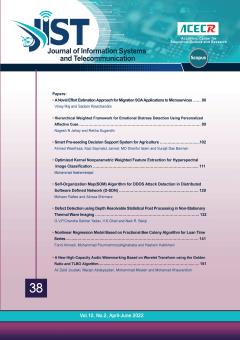-
-
List of Articles
-
Open Access Article
1 - A Novel Effort Estimation Approach for Migration of SOA Applications to Microservices
Vinay Raj Sadam Ravichandra -
Open Access Article
2 - Hierarchical Weighted Framework for Emotional Distress Detection using Personalized Affective Cues
Nagesh Jadhav -
Open Access Article
3 - Smart Pre-Seeding Decision Support System for Agriculture
Ahmed Wasif Reza Kazi Saymatul Jannat MD.Shariful Islam Surajit Das Barman -
Open Access Article
4 - Optimized kernel Nonparametric Weighted Feature Extraction for Hyperspectral Image Classification
Mohammad Hasheminejad -
Open Access Article
5 - Self-Organization Map (SOM) Algorithm for DDoS Attack Detection in Distributed Software Defined Network (D-SDN)
Mohsen Rafiee Alireza shirmarz -
Open Access Article
6 - Defect Detection using Depth Resolvable Statistical Post Processing in Non-Stationary Thermal Wave Imaging
G.V.P. Chandra Sekhar Yadav V. S. Ghali Naik R. Baloji -
Open Access Article
7 - Nonlinear Regression Model Based on Fractional Bee Colony Algorithm for Loan Time Series
Farid Ahmadi Mohammad Pourmahmood Aghababa Hashem Kalbkhani -
Open Access Article
8 - A New High-Capacity Audio Watermarking Based on Wavelet Transform using the Golden Ratio and TLBO Algorithm
Ali Zeidi joudaki Marjan Abdeyazdan Mohammad Mosleh Mohammad Kheyrandish
-
The rights to this website are owned by the Raimag Press Management System.
Copyright © 2017-2025







